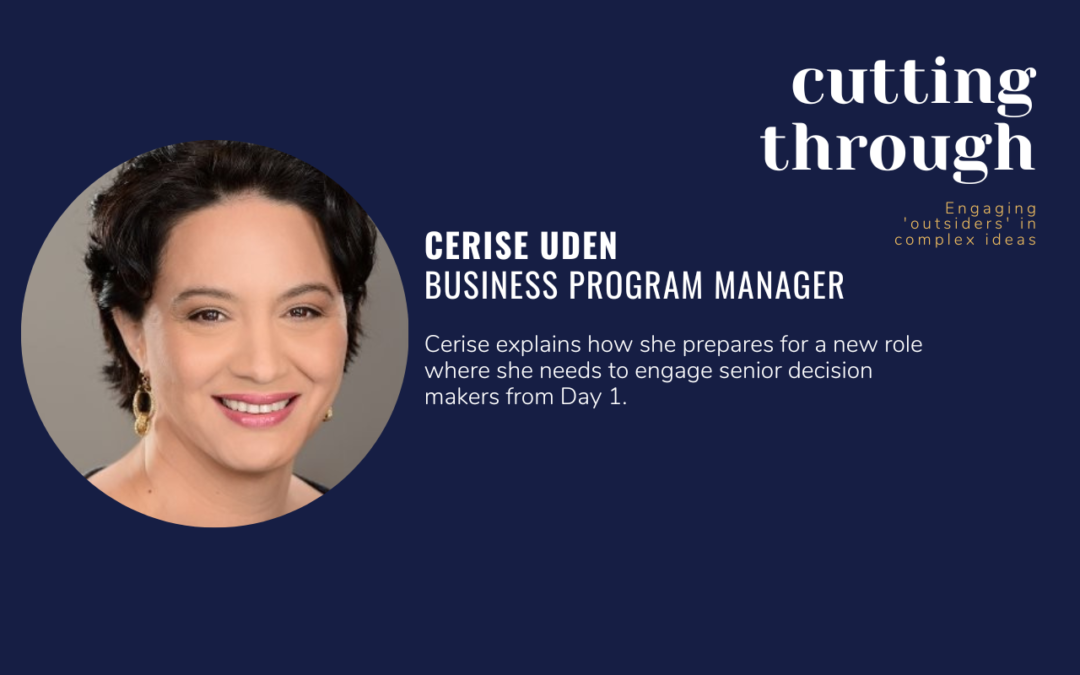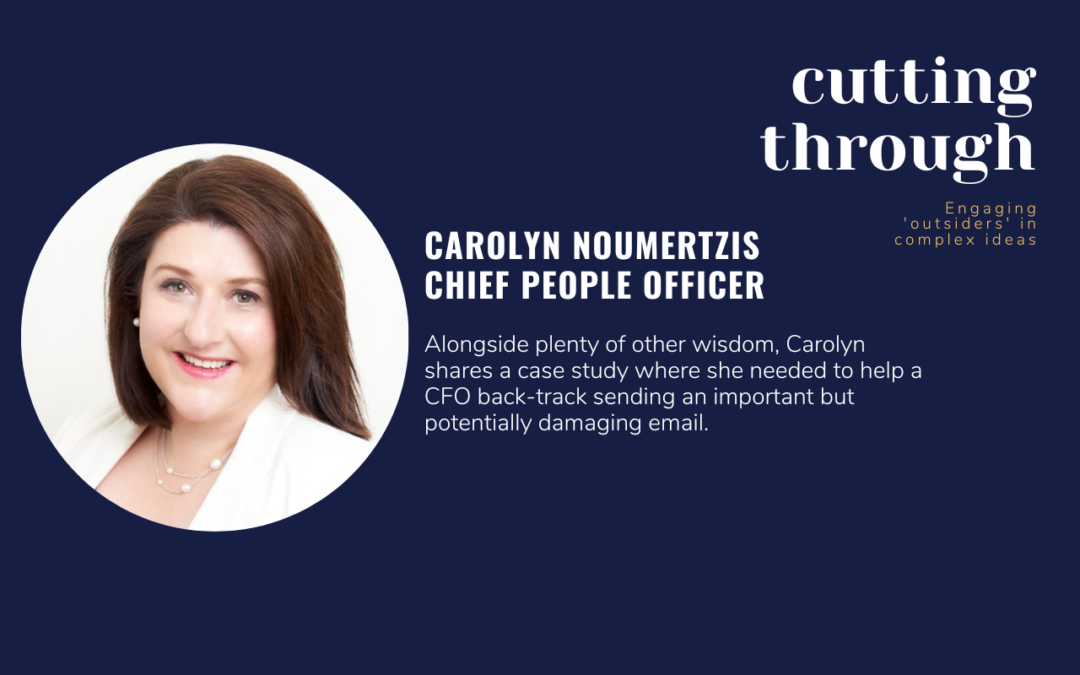No Results Found
The page you requested could not be found. Try refining your search, or use the navigation above to locate the post.

Helping experts
engage ‘outsiders'
in complex ideas
Have you ever wondered how senior people hit the ground running in a new role?
I recently spoke with Cerise Uden about her strategies for doing that on the Friday before she started a new senior program manager role.
At the simplest level, we talked about preparation.
It got really interesting when we got into the detail, though.
Cerise shared her simple yet specific approach for quickly engaging and delivering for senior decison makers. We discussed how to
00:00 – Introductions
00:49 – Get to know Cerise
06:29 – Preparing to ‘get in the zone’ quickly
06:57 – Step 1 – Get the lay of the land
08:07 – Step 2 – Use the Smart Framework to identify who am I here to deliver to and what do they want.
20:33 – Step 3 – Listen
24:58 – Step 4 – Make connections
27:28 – Case study discussion – most difficult start in a new role
31:20 – Case Study discussion – how to deal with leaders changing the end line as you’ve started role
44:36 – Case Study Discussion – Upskilling quickly for role in new area
53:35 – Final advice for someone stepping into new role
The page you requested could not be found. Try refining your search, or use the navigation above to locate the post.

Over the past two weeks I have shared two ideas to help you lift the quality of your own papers and presentations.
Today I share the third. It might seem like an odd one, but bear with me. It’s about velocity.
How quickly can you develop and deliver powerful insights that lead to fast, high-quality decisions?
In reading Colin Bryar and Bill Carr’s excellent book, Working Backwards, which describes Amazon’s secret to success many insights stood out.
The principle of velocity was one of them.
Amazon has gone to great lengths to maintain velocity in all areas of its operations so it can maintain its ability to execute quickly on innovative business lines.
Great effort is taken to remove bottlenecks and keep the teams on their ‘front foot’.
Communication is one of those areas. I see an opportunity to insert structure and discipline into the communication process just as you might any other business process.
Imagine this: Could board papers receive ‘minimal adjustments’ at each layer of your organization’s approval chain? Even better when the Board approves the idea the first time it is presented.
My client from the supply chain team at a large retailer, coined a term that I’ve borrowed: they call it the Gold Standard. Here’s how it works:
Someone prepares their highly structured one-pager either alone or with colleagues, before socialising that page with stakeholders. This triggers constructive debate around the big picture ideas and how they connect with the data. By socialising a one-page ‘message map map’ rather than a polished document at least four important things happen.
Once the ideas are locked in, the paper is prepared and sent up the chain for, hopefully, only minor adjustment.
In this model, teams focus on finessing ideas rather than tweaking words, fiddling with PowerPoint connectors or following a format.
This liberates you and your team from the awful game of ‘red pen ping pong’ so you can focus on higher order activities.
Our clients frequently see a 30 percent lift in velocity when drafting papers and presentations. This impacts both team members and leaders. Some teams, such as those outlined in the next section, achieve materially more than that.
Before establishing some concrete goals for you and your team let’s be inspired by what is possible.
Ask yourself: What do you need to change to get to the Gold Standard for you and your team?
I hope that helps.
Davina
PS. You can find the first two parts of this series on Communication Quality here:
How often has your communication led to a...
A Board Director recently described his problem...
Do you struggle to make time for strategic...
Late November is the time when many of us are...
I was sharing war stories with one of my...
I am excited to announce that I have begun a...

I love what I do.
I help senior leaders and their teams prepare high-quality papers and presentations in a fraction of the time.
This involves 'nailing' the message that will quickly engage decision makers in the required outcome.
I leverage 25+ years' experience including
My approach helps anyone who needs to engage senior leaders and Boards.
Recent clients include 7Eleven, KPMG, Mercer, Meta, Woolworths.
Learn more at www.clarityfirstprogram.com
(*) Numbers are based on 2023 client benchmarking results.

Last week I introduced the most important metric for evaluating whether communication is of a high standard or not. It’s not what you think.
If you haven’t read it yet, go here.
Today I move onto sharing my second ingredient for quality communication: quality of insight.
Let me ask: Do your papers deliver significant value to your project, team or organisation? Do they connect some dots to offer a new idea that adds value to the strategy, returns, processes or perhaps by reducing risk?
This relates to synthesis, which is where both the challenge and opportunity lie when improving high-stakes communication.
In his 2005 book A Whole New Mind best-selling author Daniel Pink commented synthesis as the ‘killer app’ in business in what he calls the new Conceptual Age.
Or more simply, the formula we used at McKinsey is that synthesis is summary + insight.
Without wanting to be too pointy about it, Daniel Pink was right. Most people can summarise. So can natural language processing tools such as ChatGPT, if given the right data set.
The real value we humans bring is to connect that factual summary with our own insights stemming from our understanding of the context.
So, to offer high-quality, valuable insights, you need to be technically strong and in touch with commercial and stakeholder imperatives.
This means that you and your leaders need to work together. You need a common strategy for tying together complex ideas to make them seem simple.
You need a structured way to collaborate when synthesising your message.
So, ask yourself about the consequences of delivering poor-quality insights. How well thought through are the ideas your team shares with you?
When it works, individuals and teams get the balance right between the import of the message, the value it delivers and the time they invest to prepare it.
And, as I mentioned last week, they do it with minimal rework.
This brings me to my third ingredient, velocity, which I’ll talk about next week.
Cheers,
Davina
How often has your communication led to a...
A Board Director recently described his problem...
Do you struggle to make time for strategic...
Late November is the time when many of us are...
I was sharing war stories with one of my...
I am excited to announce that I have begun a...

I love what I do.
I help senior leaders and their teams prepare high-quality papers and presentations in a fraction of the time.
This involves 'nailing' the message that will quickly engage decision makers in the required outcome.
I leverage 25+ years' experience including
My approach helps anyone who needs to engage senior leaders and Boards.
Recent clients include 7Eleven, KPMG, Mercer, Meta, Woolworths.
Learn more at www.clarityfirstprogram.com
(*) Numbers are based on 2023 client benchmarking results.

When trying to work out if your communication is any good or not, do you wonder what is the most important measure of success?
I have an unusual take on it.
When it comes to important papers, my hunch is that the single most important needle to move is the amount of time you and your colleagues spend reworking them.
If there is little rework, then they are fit for purpose. If there is much, it’s not a good sign for anyone.
That single measure may be enough. You may, however, like to dig a little deeper.
This week I’d like to offer the first of three measures you can use. Let me give you a preview and then dive into today’s topic: Clarity.
Let me now dig into the first of these. Can you glean the core messages within 30 seconds of opening a paper or presentation?
This is where we ask whether the communication misses the mark. Are you
We ask how well the messages jump off the page (or out of the mouth) so that your audience can grasp them quickly. How easy are they to find in the paper, presentation, discussion, email or other communication form?
Clarity helps us quickly see what the message is and check whether it does what is needed.
As one board director suggested recently, she would rather read papers that did not require him to conduct an Easter egg hunt. She does not enjoy hunting around ‘the garden’ of the paper to find where the insights are hidden.
She wants them to pop off the page so she can quickly skim the paper to decide how to read it.
Try asking how often a reader can glean the message within 30 seconds of opening the paper. You can also apply this to emails and other communication too.
While clarity is critical, though, it’s not enough. To quote one of my ‘crustier’ clients, the head of credit risk at a large bank:
“The team can now craft much clearer messages, which is very useful. But how do we stop them putting ‘rubbish’ in the boxes?”.
This leads me to my next dimension: quality of insight, which I’ll dive into next week.
Cheers,
Davina
How often has your communication led to a...
A Board Director recently described his problem...
Do you struggle to make time for strategic...
Late November is the time when many of us are...
I was sharing war stories with one of my...
I am excited to announce that I have begun a...

I love what I do.
I help senior leaders and their teams prepare high-quality papers and presentations in a fraction of the time.
This involves 'nailing' the message that will quickly engage decision makers in the required outcome.
I leverage 25+ years' experience including
My approach helps anyone who needs to engage senior leaders and Boards.
Recent clients include 7Eleven, KPMG, Mercer, Meta, Woolworths.
Learn more at www.clarityfirstprogram.com
(*) Numbers are based on 2023 client benchmarking results.

Helping experts
engage ‘outsiders'
in complex ideas
Have you been in a position where you have seen a senior leader make a big mistake?
In this interview Carolyn Noumertzis shared how she helped a Chief Financial Officer work back from a potentially disastrous email sent to the whole organisation. She also shares plenty of other wisdom on how to leverage your greatest detractors to refine your message, how to radically cut the number of emails you receive and how to keep your team in alignment.
Throughout this discussion Carolyn brings depth of experience as a senior people leader with experience across a broad range of industries.
0:00 – Introduction
00:43 – Get to know Carolyn
02:13 –The Misstep
05:31 – The Lesson
10:15 – The Solution
13:54 – Discussing ways to make better communication decisions
The page you requested could not be found. Try refining your search, or use the navigation above to locate the post.